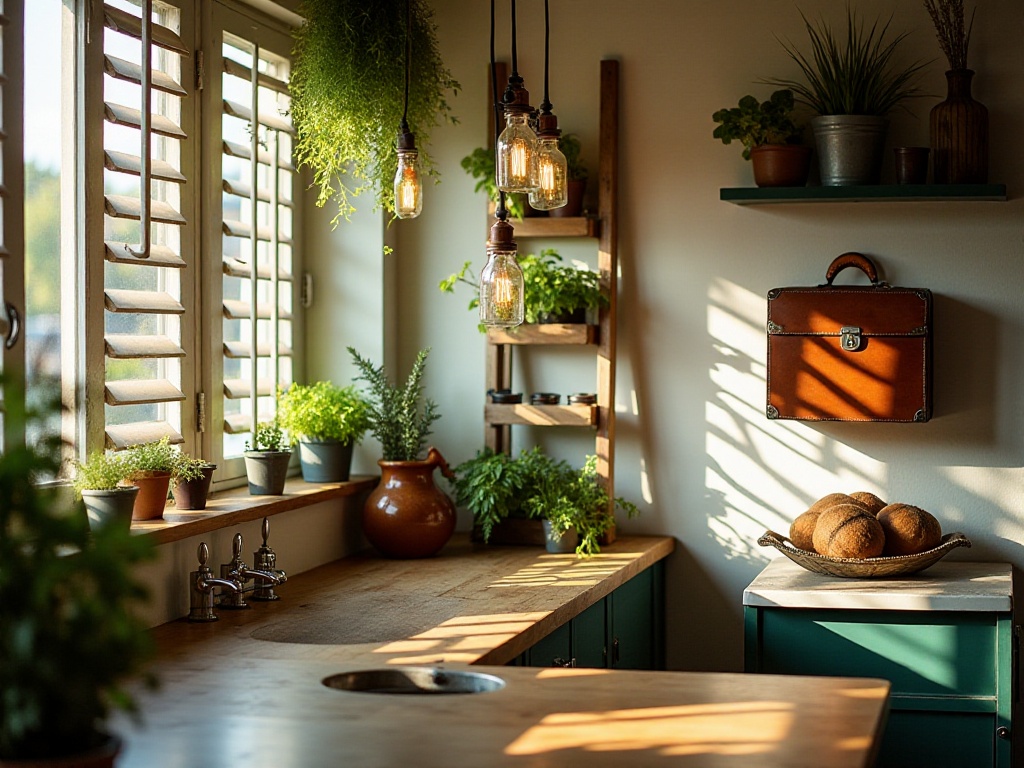Introduction
My kitchen has finally transformed from a "dump" to a "model room"! Honestly, every time I walked into the kitchen before, I felt suffocated - condiment bottles scattered everywhere, pots and pans in disarray, and small items with no proper place. After research and practice, I finally found an excellent organization system, which I'm sharing today to help make your kitchen as perfect as a magazine photo.
Space Planning
When it comes to organization, utilizing every inch of space is crucial. After observing many friends' kitchens, I noticed most people only use half their space, with the rest either wasted or cluttered with miscellaneous items. Through proper planning, kitchen space utilization can be doubled!
For example, cabinet door backs are super useful storage areas that many people overlook. A standard double-door cabinet can fit at least 4 hooks or 2 storage racks on its back. With 8 cabinets in my kitchen, the door backs alone added 32 hooks, solving the small item storage problem.
Walls and corners are often overlooked spaces too. I installed an expandable shelf next to the sink for cleaning supplies like dish soap and scrubbers, plus a place to dry cloths. A corner storage rack turned a dead space into an efficient storage area.
Many might think their kitchen is too small to fit everything. However, even the smallest space can achieve perfect organization with proper planning. For instance, I created a storage cabinet by making holes in the wall between my balcony and kitchen, solving storage issues without taking up kitchen space.

Organization Principles
After helping over 200 friends organize their kitchens, I developed a super practical "sandwich organization principle." Like making a sandwich, items are organized into three layers. This method is simple to learn and incredibly useful!
The top layer is for light, frequently used items. I keep daily-use condiments and commonly used utensils here for easy access without stretching or bending. The middle layer holds medium-weight items used occasionally, like rice cookers, food processors, and spare utensils and condiments.
The bottom layer is for heavy and rarely used items. Rice bags, oil containers, and special occasion dinnerware all go here. This layering follows ergonomic principles and prevents heavy items from damaging others.
Besides vertical layering, horizontal zoning is important. I divided the kitchen into prep, cooking, and cleaning zones. Each zone has corresponding storage designs. The prep zone drawers have dividers for organizing kitchen tools; the cooking zone has multiple hooks for hanging spatulas and strainers.

Practical Tips
Condiment Storage
Organizing condiments is truly skillful! Previously, finding soy sauce meant searching everywhere. I developed a system categorizing all condiments into four types: salty, sweet, sour, and spicy.
The salty section holds soy sauce, oyster sauce, and fish sauce; sweet has sugar and honey; sour contains vinegar and lemon juice; spicy includes chili sauces and Sichuan pepper powder. Each section has different colored labels for easy identification.
I label each condiment with expiration dates. I also discovered a trick of arranging condiments by frequency of use. Daily-use items go in front, while monthly-use items can go in back.
This organization system reduced condiment search time from nearly a minute to under 15 seconds. More importantly, we no longer buy duplicate condiments or let them expire.
Cookware Storage
The biggest mistake in cookware storage is stacking horizontally. This scratches pot bottoms and makes retrieval difficult, often requiring removing everything on top to reach bottom items.
I now store pots vertically. With a divider installed in the cabinet, pots stand like books. This saves 35% space and makes access easier. Plus, cookware doesn't scratch each other, extending their lifespan.
For lids, I bought a door-mounted lid rack. This saves cabinet space and provides easy access. Smaller lids can be stored vertically using bookends in cabinets.
Large cookware like woks and stock pots are arranged by usage frequency. The daily-use wok hangs on a hook near the stove for easy access. Less frequently used stock pots can be stored further away.

Tableware Storage
Many overlook the storage potential of sterilization cabinets. With simple modifications, one can become a super storage space. I added adjustable shelves to mine, now fitting 40 bowls, 30 plates, and dedicated spaces for chopsticks and spoons.
For rarely used tableware, I stack them with protective padding between layers. This saves space while preventing scratches. Delicate pieces are stored separately in protective boxes to prevent damage.

Advanced Techniques
Beyond basic organization tips, let's look at some advanced methods. Special magnetic storage strips can turn refrigerator sides into storage walls. I attached several storage racks to my fridge's side for common kitchen tools like scissors and bottle openers.
Another super useful innovation is suspended storage racks. I installed a track in the kitchen where storage racks can slide and adjust as needed. This maximizes upper space use while remaining flexible.
Smart storage is worth investing in. I bought a motion-sensor trash can that opens automatically, eliminating concerns about touching it with dirty hands. Some storage containers with sterilization functions can keep ingredients fresh longer.

Maintenance
Maintaining long-term organization is key after getting the kitchen in order. I recommend a weekly 15-minute "inspection" habit to check storage areas and adjust anything out of place.
Check if condiments are properly placed, tableware is returned, and storage racks need tightening. Regular maintenance keeps the kitchen organized and identifies issues early.
I made a rule: everything goes back immediately after use. It might seem troublesome at first, but becomes natural after three months. Now my kitchen stays clean and organized, and we never lose things.
Conclusion and Future Outlook
Organizing a kitchen isn't difficult; it requires patience and persistence. Start with the most problematic area and gradually expand to the whole kitchen. For example, begin with condiments, then move to tableware, step by step.
Good organization not only makes the kitchen look neat but improves our quality of life. Think about how satisfying it is to find things instantly instead of searching everywhere.
Finally, remember that every family's kitchen layout and habits differ - there's no universal storage solution. The key is adjusting and optimizing based on your situation to find what works best for you.
So, which area of your kitchen needs the most improvement? What storage problems trouble you most? Feel free to share in the comments - perhaps we can discuss better solutions together. After all, creating a perfect kitchen requires our collective effort and exploration.








